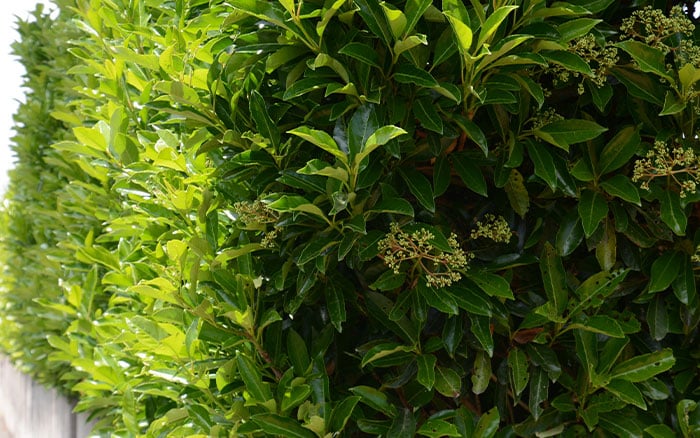For those of us with shrubs and hedges in our gardens, the best practice is to prune them regularly. Then, they can keep their shape and look good year-round. Here are some tips to hard prune overgrown shrubs and hedges.
The reality is that we either don’t have time or have inherited a garden with badly overgrown plants. So, at the end of the year, we’re looking at plants in desperate need of a chop.
It can be daunting looking at the tangled mass of stems. But the good news is, it’s quite easy to restore the shrub or hedge back to its former glory. The main thing to remember is to be bold when cutting down the stems. Because this will send signals to the plant to send out lots of new growth in the spring. It’s called rejuvenating pruning.
Many shrubs respond well to this type of hard pruning, for example, Philadelphus (mock orange), Cotinus (smoke bush), forsythia, viburnum, and lilac.
Overgrown shrubs
Hard pruning works well on mature shrubs like viburnum and mahonia bushes. Pruning very low to the ground, (leaving approximately 15cm to 30cm of the pruned stems above ground), will encourage the plant to grow vigorously in the spring, producing lots of new stems. It may seem like a drastic thing to do, but the plants really respond well.
Now is a good time of the year to hard prune many overgrown shrubs, whilst the plant is dormant.
However, shrubs that flower early in the year, such as forsythia, are better pruned immediately after flowering in the spring. Hard pruning now will remove next year’s flower buds and reduce its flowering.
Before you start, ensure you’ve got the correct pruning tools with you and that they all have clean, sharp blades.
The tools you’re likely to need are a pruning saw, a pair of loppers and secateurs.
If the shrub you’re pruning is an overgrown rose, you’ll also need a thick pair of gauntlet style gloves.
Firstly, take a good look at the shrub to identify the oldest branches which are usually darker brown and thicker than the others.
Other things to look for are the three D’s. These are dead, diseased, and dying. Finally, look for branches that are crossing with other branches as they are likely to rub their protective layer off and allow potential diseases to take hold.
If the shrub hasn’t been pruned for several years, it’s best to remove about a third of the oldest stems each year for the next three years. This way you’ll still get flowers the following year.
Then, give the shrubs a balanced nutrient feed and watering immediately after pruning.

Overgrown hedge
Hedges ideally need regular pruning twice a year. Not only will this keep them looking good, but stop them getting too wide and high. This can easily happen with mixed native hedging, privet and beech. Fortunately, they each respond well to hard pruning. Generally speaking, this time of the year is the best time to prune, whilst the hedge is dormant.
If you have overgrown conifer hedges, you’ll need to identify which type of conifer you have as only Thuja and yew can be successfully hard pruned.
The tools you’ll need will depend on the size of your hedge. Tall hedges will require use of a safe ladder (tripod types are particularly suitable for this type of working at height job) and powered hedge cutters (either electric or cordless battery powered). Small hedges can be pruned well with sharp bladed hand shears and possibly a pruning saw.
Some gardeners place a cane either end of the hedge with string tied to each cane to enable them to cut in a straight line at the top and to prune the sides to an overall even depth.
Ideally, aim to prune the hedge either mid-morning after morning dew has evaporated, or, failing that, late afternoon. Choose a day when the weather is cool, and skies are clear. This helps reduce the risk of disease setting into the cut stems after pruning.
Start by cutting off the thickest branches first. If you live in an area where snow regularly falls, try to prune the hedge top into a rounded shape to minimise internal branch damage.
If you’re using a powered hedge trimmer the best technique for achieving the right height and shape is to start at the base of the hedge. Then make large, sweeping cuts in an upwards direction before levelling off the top.
Cut one side only and the other side the following year, making sure you give the hedge a good feed and water after pruning.


Leave A Comment